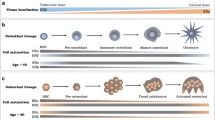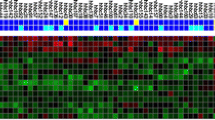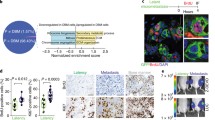Abstract
Bone metastasis is the most common metastasis in breast cancer patients. Clinical observations propose strong association between estrogen receptor (ER)-positive tumors and the development of bone metastases. We hypothesized of biologically diverse sets of hormone-dependent tumors predisposed to bone metastases and of possible role of ER-signaling pathways in the development and progression of bone metastases. We developed a novel in vitro estrogen (E2)-responsive model system, in which breast cancer cells and bone cells express high levels of either ERα or ERβ. Using co-culture approach and gene array technology we identified E2-responsive genes involved in the interaction between cancer cells and bone cells. We detected 13 genes that were altered solely by ERα and 11 genes that were regulated solely by ERβ in cancer cells. Only 5 genes were modified by both ERα and ERβ. Interestingly, the majority of genes in bone cells were altered through ERβ. Two genes, namely MacMarcks and Muc-1, whose changes in expressions in cancer cells in response to E2 were highly significant, were selected for immunohistochemical analysis using tissue microarrays of 59 infiltrating ductal carcinomas. Our results indicated that both MacMarcks and Muc-1 were expressed at high frequency in ER-positive tumors. The correlation between ERα- and ERβ-status of hormone-dependent tumors with combined expression of these two markers might suggest a more aggressive tumor phenotype associated with bone metastases. Further analysis of tissues with clinicopathological characteristics and known bone metastatic disease will indicate potential prognostic values of these and other markers in the development of bone metastases in a subgroup of “bad” hormone-dependent breast cancer.





Similar content being viewed by others
Abbreviations
- ERα:
-
Estrogen receptor alpha
- ERβ:
-
Estrogen receptor beta
- E2:
-
17-β estradiol
- F:
-
Fulvestrant
- Dox:
-
Doxycycline
- MDA-ERα:
-
MDA-MB-231 cells stably transfected with ERα
- MDA-ERβ:
-
MDA-MB-231 cells stably transfected with ERβ
- U2OS:
-
Osteosarcoma cells
- TMA:
-
Tissue microarrays
- ERE:
-
Estrogen response element
- RT-PCR:
-
Reverse transcriptase polymerase chain reaction
- MEM:
-
Minimum essential medium
- DMEM/F12:
-
Dulbecco’s Modified Eagle’s medium
- IHC:
-
Immunohistochemical
- ECM:
-
Extracellular matrix
- MMP:
-
Matrix metalloproteinase
- TGFβ:
-
Transforming growth factor beta
- FGF:
-
Fibroblast growth factor
- OPN:
-
Osteopontin
- MacMarcks:
-
Myristoylated alanine-rich C kinase substrate
- Muc-1:
-
Mucin 1
- PKC:
-
Protein kinase C
- MAP:
-
Mitogen activated protein
- RANK:
-
Receptor activator of NF-κB
- RANKL:
-
Receptor activator of NF-κB ligand
- CFS:
-
Colony-stimulating factor
- ErbB-2:
-
Erythroblastic leukemia viral oncogene homolog 2
- vs:
-
Versus
References
Campbell FC, Blamey RW, Elston CW et al (1981) Oestrogen-receptor status and sites of metastasis in breast cancer. Br J Cancer 44:456–459
Kamby C, Rasmussen BB, Kristensen B (1989) Oestrogen receptor status of primary breast carcinomas and their metastases. Relation to pattern of spread and survival after recurrence. Br J Cancer 60:252–257
Koenders PG, Beex LVAM, Langens R et al (1991) Steroid hormone receptor activity of primary human breast cancer and patterns of first metastasis. Breast Cancer Res Treat 18:27–32
Fuqua SAW (2002) The role of estrogen receptors in breast cancer metastasis. J Mammary Gland Biol Neopl 6:407–417
Mundy GR (2002) Metastasis to bone: causes, consequences and therapeutic opportunities. Nature Rev 2:584–593
Rosol TJ, Tannehill-Gregg SH, LeRoy BE et al (2003) Animal models of bone metastasis. Cancer 97(3 Suppl):748–757
Jiang SY, Jordan VC (1992) Growth regulation of estrogen receptor-negative breast cancer cells transfected with complementary DNAs for estrogen receptor. J Natl Cancer Inst 84:580–591
Tonetti DA, Rubenstein R, DeLeon M et al (2003) Stable transfection of an estrogen receptor beta cDNA isoform into MDA-MB-231 breast cancer cells. J Steroid Biochem Mol Biol 87:47–55
Monroe DG, Getz BJ, Johnsen SA et al (2003) Estrogen receptor isoform-specific regulation of endogenous gene expression in human osteoblastic cell lines expressing either ERα or ERβ. J Cell Biochem 90:315–326
Levenson AS, Kwaan HC, Svoboda KM et al (1998) Weiss IM, Sakurai S, Jordan VC. Oestradiol regulation of components of the plasminogen-plasmin system in MDA-MB-231 human breast cancer cell stably expressing the oestrogen receptor. Br J Cancer 78:88–95
Levenson AS, Tonetti DA, Jordan VC (1998) The oestrogen-like effect of 4-hydroxytamoxifen on induction of transforming growth factor alpha mRNA in MDA-MB-231 breast cancer cells stably expressing the oestrogen receptor. Br J Cancer 77:1812–1819
Levenson AS, Gehm BD, Timm Pearce S et al (2003) Resveratrol acts as an estrogen receptor (ER) agonist in breast cancer cells stably transfected with ERα. Int J Cancer 104:587–596
Wang J, Levenson AS, Satcher RL (2006) Identification of a unique set of genes altered during cell-cell contact in an in vitro model of prostate cancer bone metastasis. Int J Mol Med 17:849–856
Levenson AS, Svoboda KM, Pease KM et al (2002) Gene expression profiles of the ER-SERM complex in breast cancer cells expressing wtER. Cancer Res 62:4419–4426
Levenson AS, Jordan VC (1994) Transfection of human estrogen receptor (ER) cDNA into ER-negative mammalian cell lines. J Steroid Biochem Mol Biol 51:229–239
Harris SA, Tau KR, Turner RT et al (1996) Estrogens and progestins. In: Bilezikian JP (ed) Principles of bone biology. Academic Press, San Diego, pp 507–520
Davis VL, Couse JF, Gray TK et al (1994) Correlation between low levels of estrogen receptors and estrogen responsiveness in two rat osteoblast-like cell lines. J Bone Miner Res 9:983–991
Solomayer E-F, Diel IJ, Meyberg GC et al (2000) Metastatic breast cancer: clinical course, prognosis and therapy related to the first site of metastasis. Breast Cancer Res Treat 59:271–278
Coleman RE, Smith P, Rubens RD (1998) Clinical course and prognostic factors following bone recurrence from breast cancer. Br J Cancer 77:336–340
James JJ, Evans AJ, Pinder SE et al (2003) Bone metastases from breast carcinoma: histopathological-radiological correlations and prognostic features. Br J Cancer 89:660–665
Roger P, Sahla ME, Makela S et al (2001) Decreased expression of estrogen receptor beta protein in proliferative preinvasive mammary tumors. Cancer Res 61:2537–2541
Shaw JA, Udokang K, Mosquera JM et al (2002) Estrogen receptors alpha and beta differ in normal human breast and breast carcinomas. J Pathol 198:450–457
Hopp TA, Weiss HL, Parra IS et al (2004) Low levels of estrogen receptor beta protein predict resistance to tamoxifen therapy in breast cancer. Clin Cancer Res 10:7490–7499
Bardin A, Boulle N, Lazennec G et al (2004) Loss of ER beta expression as a common step in estrogen-dependent tumor progression. Endocrine-Related Cancer 11:537–551
Wang Y, Klijn JGM, Zhang Y et al (2005) Gene-expression profiles to predict distant metastasis of lymph-node-negative primary breast cancer. Lancet 365:671–679
Perou CM, Jeffrey SS, van de Rijn M et al (1999) Distinctive gene expression patterns in human mammary epithelial cell and breast cancers. Proc Natl Acad Sci USA 96:9212–9217
Sorlie T, Perou CM, Tibshirani R et al (2001) Gene expression patterns of breast carcinomas distinguish tumor subclasses with clinical implications. PNAS 98:10869–10874
Sorlie T, Tibshirani R, Parker J et al (2003) Repeated observation of breast tumor subtypes in independent gene expression data sets. PNAS 100:8418–8423
van’t Veer LJ, Dai H, van de Vijver MJ et al (2002) Gene expression profiling predicts clinical outcome of breast cancer. Nature 415:530–535
Weigelt B, Hu Z, He X et al (2005) Molecular portraits and 70-gene prognosis signature are preserved throughout the metastatic process of breast cancer. Cancer Res 65:9155–9158
Ranuncolo SM, Armanasco E, Cresta C et al (2003) Plazma MMP-9 (92 kDA-MMP) activity is useful in the follow-up and in the assessment of prognosis in breast cancer patients. Int J Cancer 106:745–751
Nakopoulou L, Tsirmpa I, Alexandrou P et al (2003) MMP-2 protein in invasive breast cancer and the impact of MMP-2/TIMP-2 phenotype on overall survival. Breast Cancer Res Treat 77:145–155
Dallas SL, Rosser JL, Mundy GR et al (2002) Proteolysis of latent transforming growth factor-beta (TGF-beta)-binding protein-1 by osteoclasts. A cellular mechanism for release of TGF-beta from bone matrix. J Biol Chem 277:21352–21360
Clines GA, Guise TA (2005) Hypercalcaemia of malignancy and basic research on mechanisms responsible for osteolytic and osteoblastic metastasis to bone. Endocrine-Related Cancer 12:549–583
Yue L, Bao Z, Li J (2000) Expression of MacMarcks restores cell adhesion to ICAM-1-coated surface. Cell Adhes Commun 7:359–366
Rakha EA, Boyce RWG, El-Rehim DA et al (2005) Expression of mucins (MUC1, MUC2, MUC3, MUC4, MUC5AC and MUC6) and their prognostic significance in human breast cancer. Modern Pathol 18:1295–1304
Komori T (2006) Regulation of osteoblast differentiation by transcription factors. J Cell Biochem 99:1233–1239
Yang J, Mani SA, Weinberg RA (2006) Exploring a new twist on tumor metastasis. Cancer Res 66:4549–4552
Omoto Y, Kobayashi S, Inoue S et al (2002) Evaluation of oestrogen receptor β wild-type and variant protein expression, and relationship with clinicopathological factors in breast cancers. Eur J Cancer 38:380–386
Gruvberger S, Ringner M, Chen Y et al (2001) Estrogen receptor status in breast cancer is associated with remarkably distinct gene expression patterns. Cancer Res 61:5979–5984
Perou CM, Sorlie T, Eisen MB et al (2000) Molecular portraits of human breast tumours. Nature (Lond) 406:747–752
Li J, Aderem A (1992) MacMarcks, a novel member of the Marcks family of protein kinase C cubstrates. Cell 70:791–801
Wu M, Chen DF, Sasaoka T et al (1996) Neural tube defects and abnormal brain development in F52-deficient mice. Proc Natl Acad Sci USA 93:2110–2115
Ramsden JJ (2000) Marcks: a case of molecular exaptation? Int J Biochem Cell Biol 32:475–479
Yue L, Lu S, Garces J et al (2000) Protein kinase C-regulated dynamitin-macrophage-enriched myristoylated alanine-rice C kinase substrate interaction is involved in macrophage cell spreading. J Biol Chem 275:23948–23956
Aderem A (1992) The Marcks brothers: a family of protein kinase C substrates. Cell 71:713–716
Blackshear PJ (1993) The Marcks family of cellular protein kinase C substrates. J Biol Chem 268:1501–1504
Ohmitsu M, Fukunaga K, Yamamoto H et al (1999) Phosphorylation of Marcks by mitogen-activared protein kinase on cultured rat hippocampal neurons following stimulation of glutamate receptors. J Biol Chem 274:408–417
Manenti S, Malecaze F, Chap H et al (1998) Overexpression of the myristoylated alanine-rich C kinase substrate in human choroidal melanoma cells affects cell proliferation. Cancer Res 58:1429–1434
Cho SJ, La M-H, Ahn JK et al (2001) Tob-mediated cross-talk between Marcks phosphorylation and erbB-2 activation. Biochem Biophys Res Commun 283:273–277
Wesseling J, van der Valk SW, Hilkens J (1996) A mechanism for inhibition of E-cadherin-mediated cell-cell adhesion by the membrane-associated mucin episialin/ Muc1. Mol Biol Cell 7:565–577
Jarvinen TA, Pelto-Huikko M, Holli K et al (2000) Estrogen receptor beta is coexpressed with ER alpha and PR and associated with nodal status, grade, and proliferation rate in breast cancer. Am J Pathol 156:29–35
Omoto Y, Inoue S, Ogawa S et al (2001) Clinical value of the wild-type estrogen receptor β expression in breast cancer. Cancer Lett 163:207–212
Bajic VB, Tan SL, Chong A et al (2003) Dragon ERE Finder version 2:a tool for accurate detection and analysis of estrogen response elements in vertebrate genomes. Nucl Acids Res 31:3605–3607
Acknowledgments
This work was supported by a grant from Susan G Komen Breast Cancer Foundation (BCTR0504398) to ASL. We thank Dr. T. Spelsberg (Mayo Clinic and Foundation, Rochester, MN) for generous gift of U2OS-ER (α and β) cells and Dr. D. Tonetti (University of Illinois at Chicago, Chicago, IL) for MDA-ERβ cells. We are also grateful to Dr. J-A Gustafsson (Karolinska Institute, Sweden) for providing ERβ antibodies for Western blots.
Author information
Authors and Affiliations
Corresponding author
Electronic supplementary material
Rights and permissions
About this article
Cite this article
Wang, J., Jarrett, J., Huang, CC. et al. Identification of estrogen-responsive genes involved in breast cancer metastases to the bone. Clin Exp Metastasis 24, 411–422 (2007). https://doi.org/10.1007/s10585-007-9078-6
Received:
Accepted:
Published:
Issue Date:
DOI: https://doi.org/10.1007/s10585-007-9078-6




